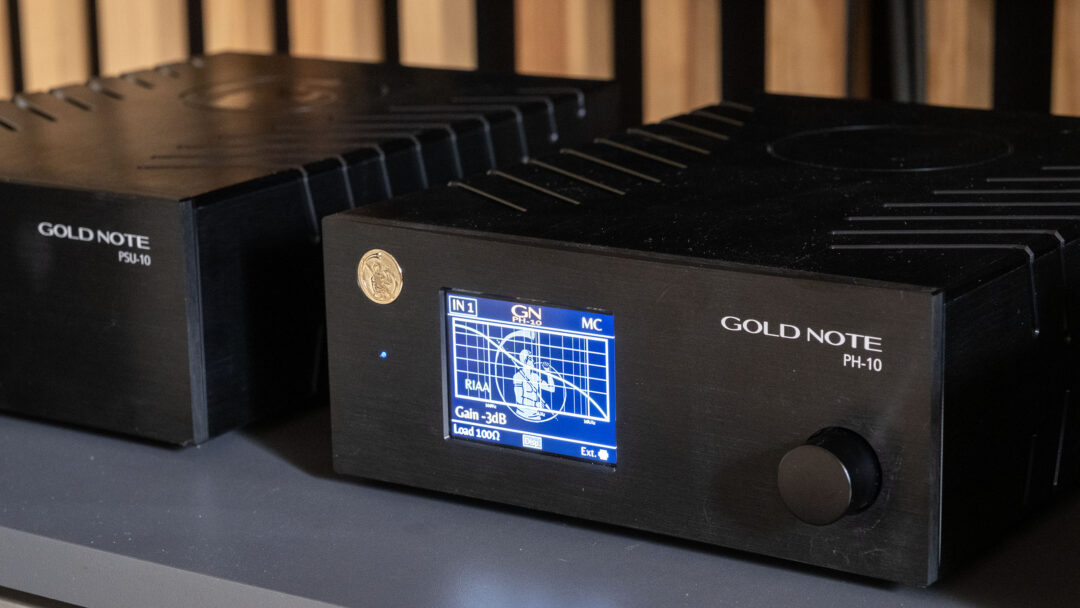Many newbies get a surprise the first time they buy a turntable. When they plug it into their amplifier, they realise there’s something strange about the sound. What many don’t realise is that all turntables need to be connected to a special input, often called phono stage, RIAA stage or simply turntable input.
Many amplifiers and some turntables have a so-called RIAA stage built in, which solves the problem of the “weird sound”.
Of course, the seasoned audiophile knows this.
This is the group that most often spends a little extra money on the sound and buys separate RIAA stages. Usually because the amplifier’s built-in isn’t good enough, and to get the most out of the grooves, they invest in both a really good cartridge and an RIAA stage.
For the first group, the solution may be a budget-friendly RIAA stage from well-known manufacturers such as Rega and Pro-Ject. For audiophiles, the choice is much wider and prices reach heights you wouldn’t have thought possible. €100,000? Sure, or more if you really want to splurge on an expensive RIAA stage.
Fortunately, the Italian Gold Note PH-10 is not quite that expensive.
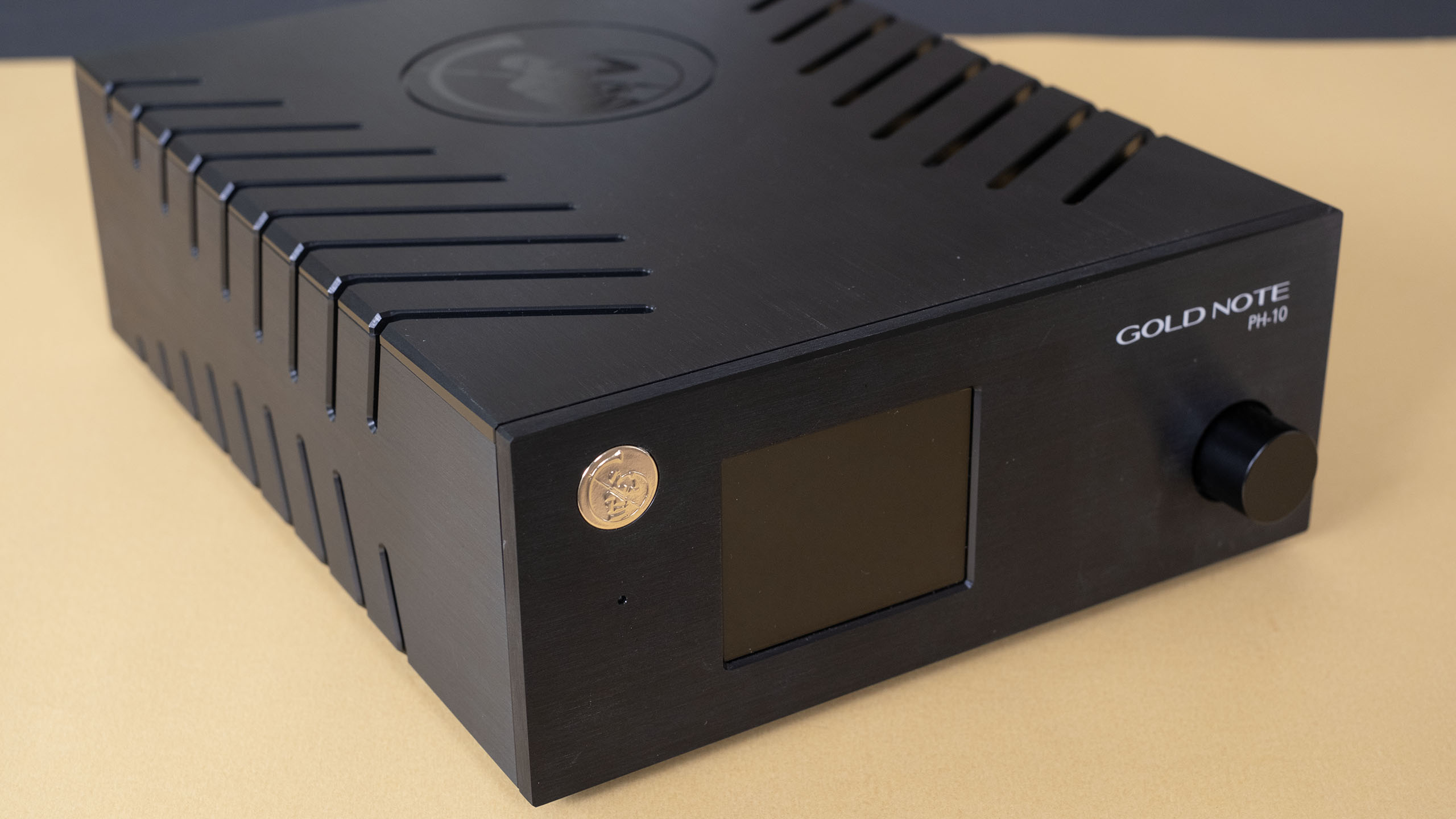
It’s a compact RIAA stage, or phono stage as many call it, that can do a little more than expected. Gold Note is a fairly young company, founded in 2012 and thus considerably younger than Sonus faber, for example. Gold Note is based not far from Florence and, like many other Italian companies, is inspired by the dazzlingly beautiful nature of Tuscany.
The Mediterraneo turntable has a plinth that looks like it was inspired by the rolling hills of Tuscany, and some of the company’s products bear famous Italian names such as Donatello and Machiavelli.
RIAA?
But first, a quick explanation. RIAA is the acronym for Record Industry Association of America, a trade association for the recording industry in the US. But it’s also a technical standard for vinyl records and describes the frequency curve used for vinyl pressings.
This curve looks like an ascending diagonal on a chart, where the lowest frequencies are attenuated while the highest frequencies are amplified. This saves groove width, allowing more music to fit on an LP side.
Therefore, to play a vinyl record with RIAA-EQ, you need an RIAA stage that compensates for the RIAA curve.
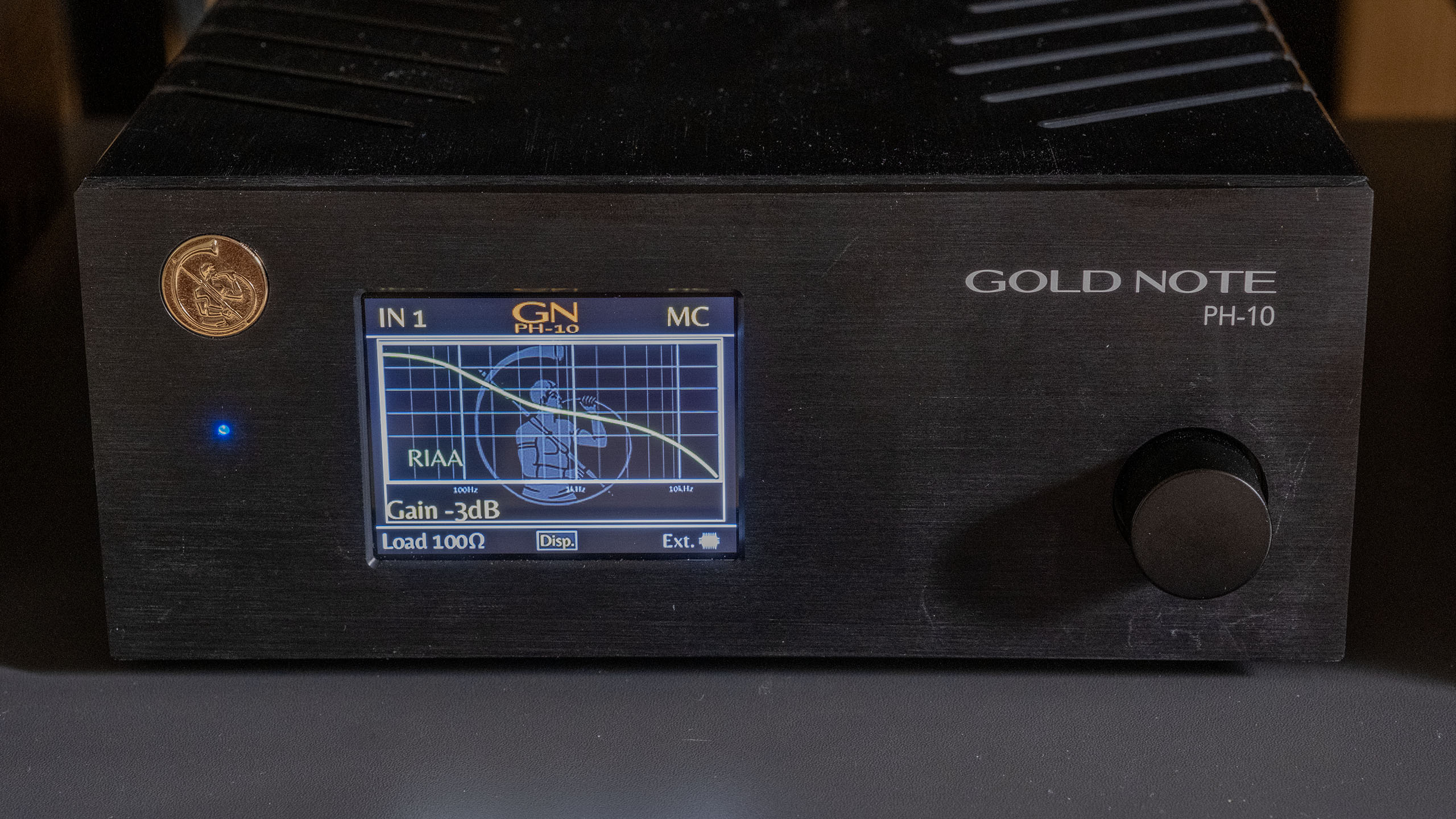
All phono stages, turntable inputs or RIAA stages have this RIAA EQ. This applies regardless of whether you have an MM or MC (Moving Magnet and Moving Coil) pickup. However, the Gold Note PH-10 also has the Decca-London and Columbia recording curves, which are roughly similar to the RIAA curve, but they are largely only relevant for collectors with very old recordings that were recorded with these recording curves.
For the vast majority of people, RIAA applies, and it’s been that way for 60 years.
Set everything yourself
On the Gold Note PH-10, you can see the selected recording curve on a small colour screen. It also shows whether you are using MM or MC pickup, gain in dB, load impedance and which of the two inputs you have selected.
The PH-10 has inputs for two pickups and turntables, as well as both balanced and unbalanced outputs. It also has a dedicated DIN connector for an external power supply. For example, the Gold Note PSU-10 power supply that we used to test the PH-10.
There is also a USB input on the back for any software updates.
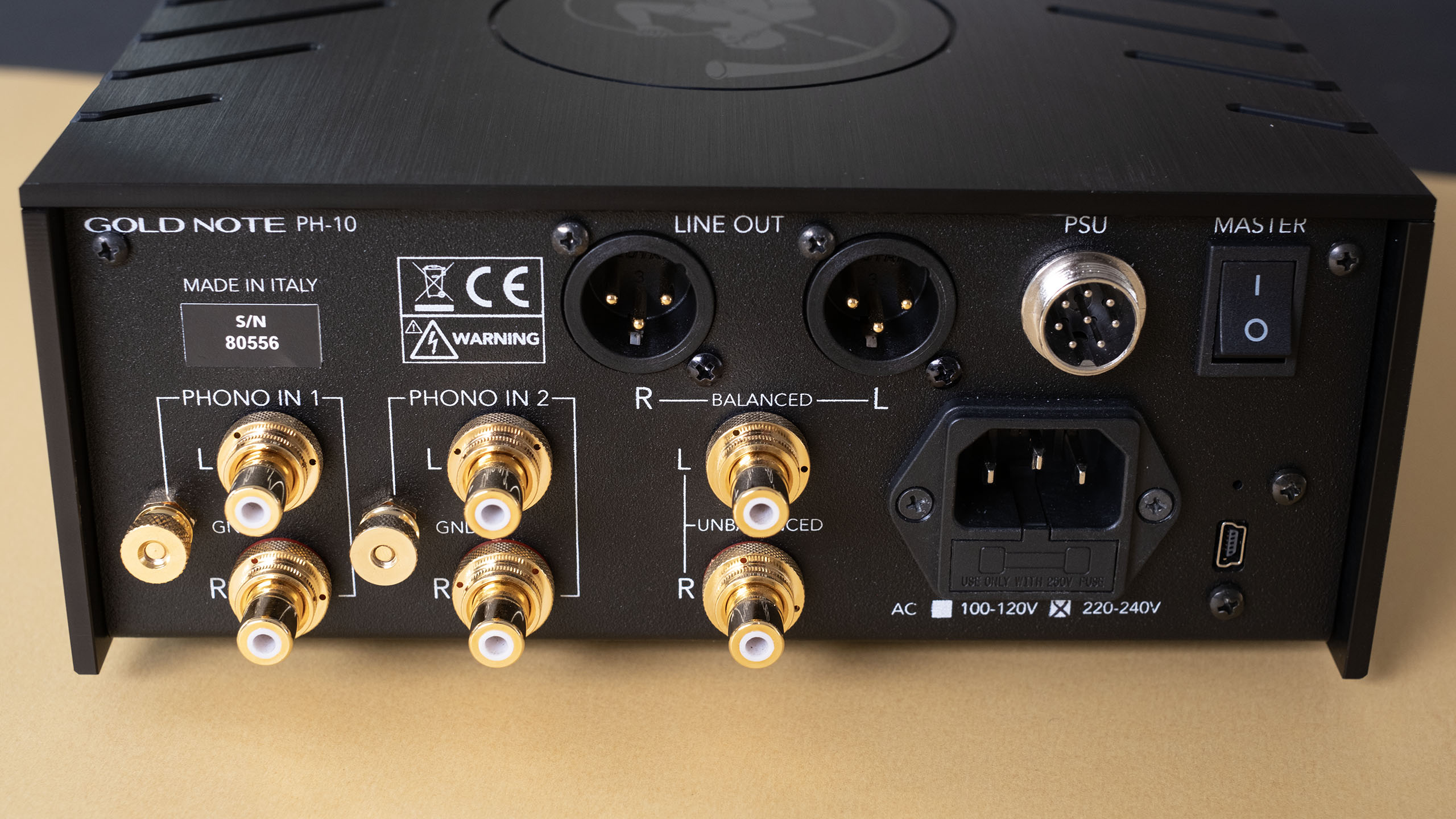
As with many other expensive RIAA stages, you can set the load impedance of the pickup yourself. Most MC pickups need between 50 and 200 ohms, but some are extra sensitive and work best below 50 ohms, while others need a much higher load impedance.
Here you can set it from 10, 22, 47, 100, 220, 470, 1,000 and 22k to 47k ohms. The latter is only used for MM pickups or some MC pickups with very high output voltage.
All of this, including gain, can be set from the potentiometer on the front, so you don’t have to unscrew the top cover to flip hopelessly small dip switches to the correct position on a circuit board. All settings can be made with a push and turn of the potentiometer, and can be done without interrupting the signal or power.
PSU-10
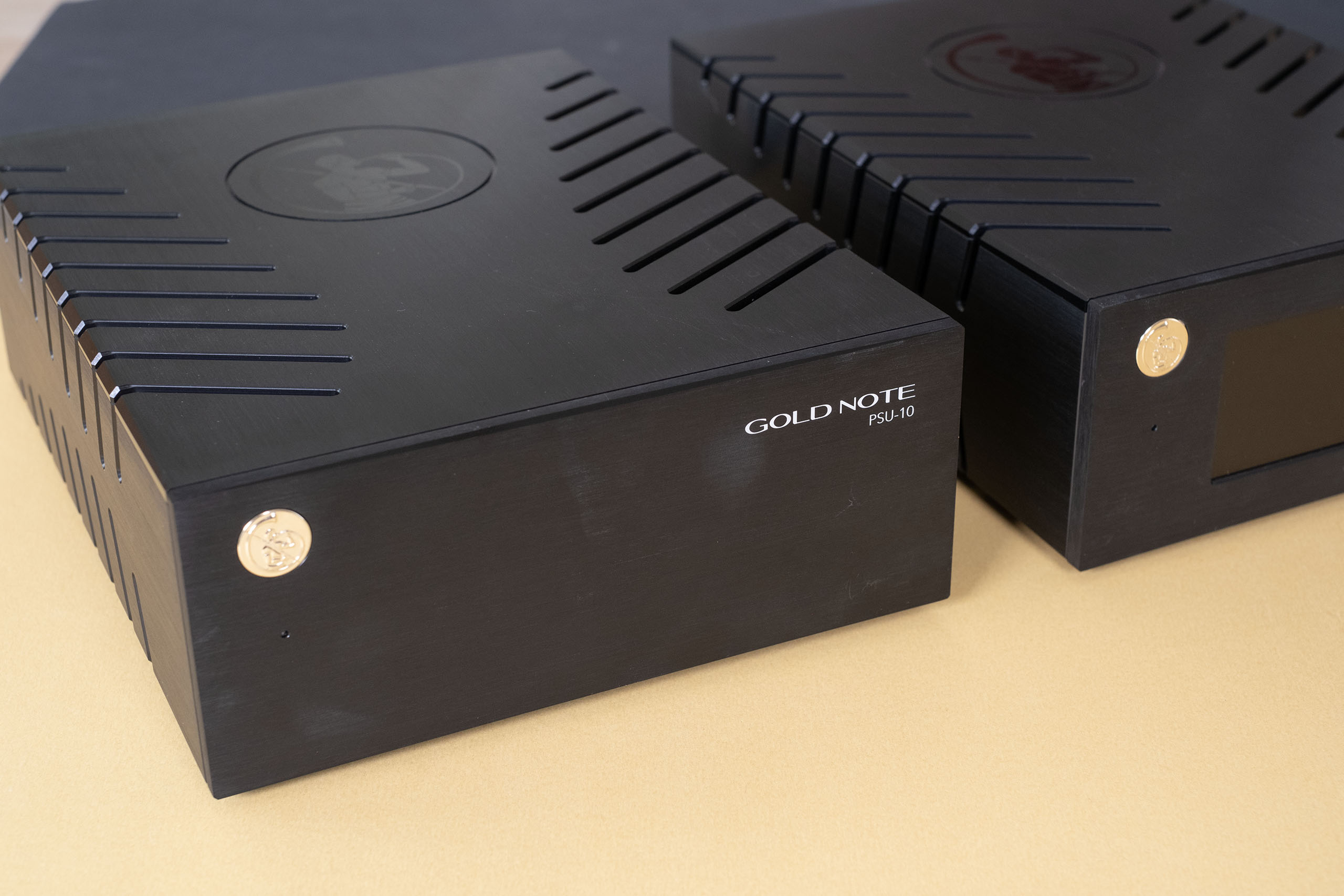
Speaking of power, the PSU-10 must be mentioned. The RIAA stage has a built-in power supply. There’s no external power adapter, you just plug in the included power cable and you’re good to go. If you want to upgrade the PH-10, you can do so with Gold Note’s separate power supply PSU-10. The point here is to lower the noise from the mains and give the RIAA stage more stable power that is unaffected by mains noise and electromagnetic interference – EMI.
The PSU-10 has four power supply stages with four low-noise voltage regulators and four transformers, one of which is connected to the Dual Choke filter. Inside the PSU-10 is a filter that removes mains noise. The enclosure is made of aluminium and the active circuits are shielded against EMI.
According to Gold Note, the power supply should be placed four to five centimetres to the left of the PH-10. Supposedly, this is the optimal location where the RIAA stage is not affected by noise from the power supply.
The sound
For the first part of the testing phase, I connected the PH-10 to the external power supply. The RIAA curve was selected and the impedance and gain were matched to both an MC and an MM pickup. Both from Ortofon.
It quickly became clear that the PH-10 is a step up in sound quality compared to, for example, a Rega Aria. Which is an excellent RIAA stage in every way. The soundstage is bigger, more open and fuller with the PH-10, but not as weightless and resolved as the Audio Research PH9. Which, of course, costs many times the price of a PH-10.
I noted that the PH-10 was largely silent – no audible noise. However, if you turn up the volume a lot, you can hear a faint background noise if you use an MC pickup with a very low output voltage.
A better phono stage may be what it takes to lift even the smallest nuances out of the grooves on the vinyl.
Compared to the phono input on a Yamaha A-S3200, and most other integrated amplifiers for that matter, the soundstage from the PH-10 is wider and has greater dynamic contrast. There’s also more weight and power in the bass, and it’s even easier to follow double bass and percussion with the PH-10. In many ways, it’s similar to the Primare R35, which is one of the best we’ve tested in this class, but the R35 lacks the PH-10’s easy adjustability with a colour screen that constantly displays settings.
Mark Knopfler’s guitar tone is rendered with an organic warmth that makes the sound more believable and more present. The larger drums in the percussion are rendered with authority and a depth you can feel in your body. Keith Jarrett’s piano sound is fuller, and again, it’s in the bass that you realise that the PH-10 has better control and more power over the lowest notes than the aforementioned Rega-RIAA. And the Yamaha amplifier’s turntable input.
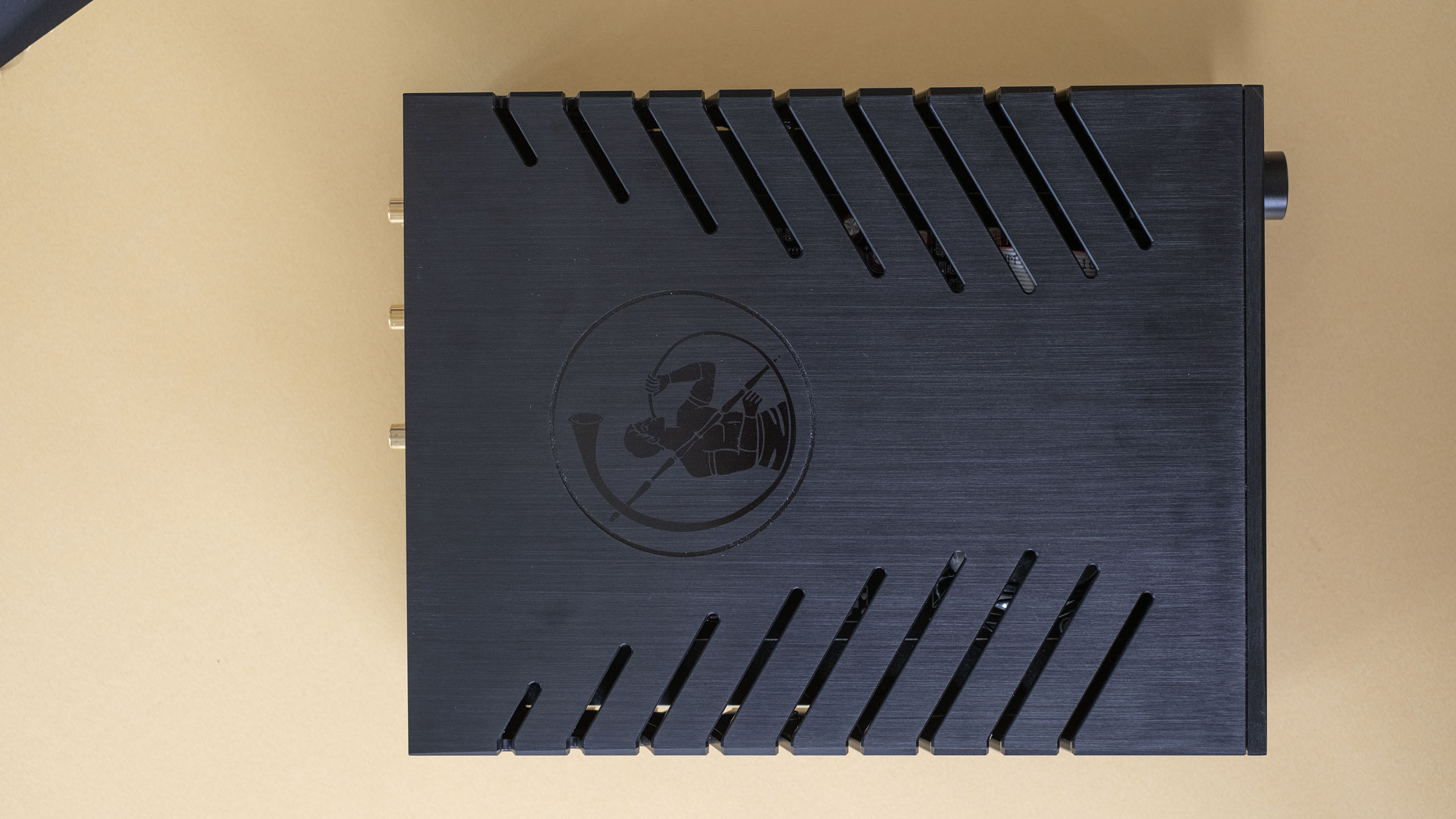
The sound isn’t as open as a PH9, and the focus on micro details isn’t as great. But plug in the PSU-10 power supply and you’ll immediately notice a boost in sound.
The power supply amplifies everything the PH-10 does, and this is especially noticeable in the bass, which becomes tighter and even more potent. The sound also tightens up, opening up more and improving dynamic contrast. This can be heard on the Keith Jarrett Trio’s live recording Still Live. Here, the double bass is fuller and the focus is sharper. You can also hear it in the piano sound, which sounds more like the notes of a concert piano.
The recording curves can be changed at any time from RIAA – with or without enhance/lift in the treble – to Decca-London and Columbia, and after a brief second of unplugging, you can easily hear how differently the music on an LP is reproduced with the different curves. Personally, I preferred RIAA – without enhance – because it always provided the best balance in the soundstage.
Conclusion
The Gold Note PH-10 is one of the most flexible and best-sounding RIAA or phono stages we’ve tested. It’s also the easiest to use of any we’ve tested in this class, and with the ability to upgrade the sound with a better power supply, you can have the PH-10 for many years before feeling the need to replace it. Should you be the lucky owner of a collection of very old vinyl, recorded with the Decca-London or American Columbia curves, it’s hard to find alternatives to the PH-10. Regardless of price range.

We think
Highly customisable. Both MM and MC with plenty of adjustment options. Large, open and dynamic soundstage. Can be upgraded with PSU-10 for even better sound. Faint background noise can occur with MC pickups with very low output voltage.
1790 €
Specifications
- Type: Phono preamplifier (MM/MC)
- Technology: Discrete transistor, symmetrical dual-mono
- Connections: RCA unbalanced in/out, XLR balanced out, PSU
- Load (ohms): 10, 22, 47, 100, 220, 470, 1,000, 22k, 47k
- Capacitance: 220 pF
- EQ: RIAA, Decca-London, American Columbia
- Gain: 65 dB MC, 45 dB MM
- Signal to noise: -89 dB
- Dynamic range: 105 dB
- Dimensions / Weight: 22 x 26 x 8 cm / 4 kg
- Other: Available in black, silver, gold. Colour screen
- Web: goldnote.it
